Exclusion Points, Design Solutions, and Mismatched Human Interactions
According to the Inclusive ToolKit Manual by Microsoft Design, “points of exclusion help us generate new ideas and inclusive design. They highlight opportunities to create solutions with utility and elegance for many people” (20). This solution suggests that designers de-center themselves as main audience members in order to design for a wider array of people that would otherwise not be considered. Mismatched human interactions are when designs fail to meet people’s abilities, therefore excluding them from a given activity. In this sense, disability is not a personal health condition; Disability is a mismatched human interaction.
My primary deliverables are media platforms such as Instagram and TikTok, as well as a brand book providing my purpose behind the account (referencing Simon Sinek’s Golden Circle), logos, color palettes, typography, tone of voice, brand traits, and an in-depth analysis of engagement metrics.
Since my current Instagram and TikTok content is the same (same content, same captions and hashtags, generally same sound selection, etc.), the points of exclusion would remain generally the same on both applications. An exclusion would be neglecting the usage of the alt text feature. By not using alt text on images uploaded to Instagram, I would be limiting any visually impaired audience members from understanding the content, as well as fail to provide an alternative way of viewing for them. (For Instagram reels and TikTok videos, alt text cannot be added because it is a moving image). Keeping the idea of alt text in my mind from last semester’s Web Design & Development course, I have been generating extremely in-depth captions that can act as a form of alt text for those who may not be able to read the words on video content. These captions can be read aloud using a screen reader and provide those audience members with a step-by-step breakdown of the video and any potential questions within. However, for photos posted on Instagram and TikTok that may not need to be caption heavy, I can expand my audience and be more inclusive to visually impaired viewers by going to advanced settings and writing alt text to make my platform a more inclusive space. Failing to provide alt text centers me around my design because I am not visually impaired. By de-centering myself and mismatching human interactions, I further my journey in creating a more inclusive and welcoming environment for others.
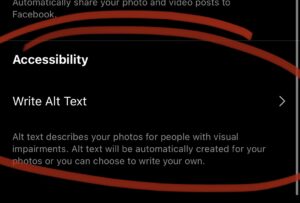
Similar to the idea of alt text, moving forward, in any videos that require a user the ability to listen to rather than read the information, I can further expand on creating a more inclusive experience by including closed captions on CapCut. (TikTok naturally provides closed captions and can be turned on or off by the individual user at any time). Closed captions help users who are deaf or are hard of hearing to actively read, learn from, and understand the context of a given video in full. By centering myself around design, I may not add captions considering I am not hearing impaired, which promotes mismatched human interaction and consequently fails to provide a way for deaf or people hard of hearing to fully understand the video, even if a caption is provided. While the caption can act as a resource for what the video is about, it is not a full transcript, which is why we cannot rely on captions to fulfill their needs.
CapCut:
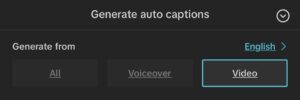
TikTok:
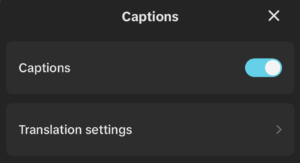
As for the brand book, I am planning on printing physical copies, as well as uploading a copy online. The physical copy can be extremely challenging for users who are visually impaired or blind, considering they cannot interact with the information on the page. With that in mind, it is crucial that I also upload a version of the brand book online, allowing visually impaired or blind users to use screen readers in order to navigate through the book. Uploading a version of the brandbook to a public space online also increases the potential traffic towards the book. This thought reminds me of how different people benefit on the Persona Spectrum; Understanding related mismatches and motivations “across a spectrum of permanent, temporary, and situational scenarios” help us “foster empathy and show how a solution scales to a broader audience” (42).
Project Distribution
I plan to distribute my project and get word out about it via social media platforms such as Instagram and TikTok. A main goal of my project is to connect with others online in the fitness realm in order to build a shared sense of community that revolves around empowerment, education, and honesty. I hope to reach mainly women within the 18-24 and 25-34 age range.
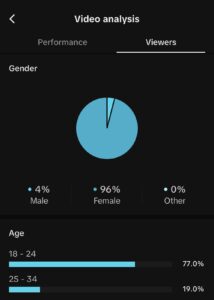
I aim to connect with others through 1.) Creating a consistent media strategy that keeps accounts consistently engaged (right now I am posting 2x a week on both Instagram and TikTok, but after spring break I plan to post 3-4 times a week on each platform).
2.) Keeping both Instagram and TikTok accounts public in order to reach and engage with the widest amount of viewers possible.
3.) Including call to action language such as “let’s hit back and biceps,” or “come to the gym with me.”
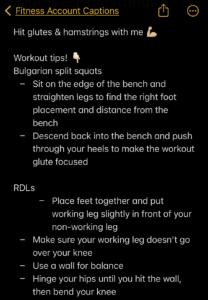
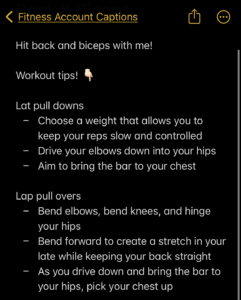
4.) Adding necessary and relevant hashtags users can easily navigate to when looking for a video under a certain category. I have been including popular hashtags for general reasons, but also hashtags with few posts in order to make my content stand out from the rest
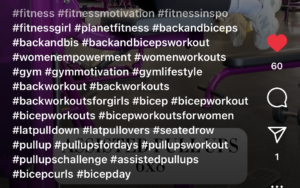
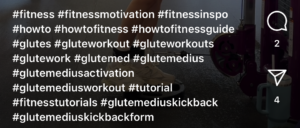
5.) Adding tags and topics that are relevant to the content. I can easily boost reel engagement by adding 3 topics per post. Mostly, I have been tagging: gym workouts, strength training, and weightlifting (under the ‘Sports’ category). Though, for example, I can also do this for videos including meal plans, protein smoothie recipes, or healthy snacks by tagging: recipes, juices & smoothies, or breakfast & brunch (under the ‘Food & Drink’ category). The possibilities are endless and provide users with ways to further reach their primary audience.
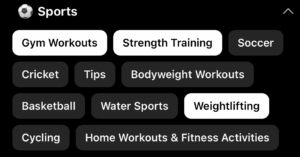
6.) Choosing specific sounds and audios for stronger Instagram reel and TikTok engagement. I can choose popular and trending sounds specifically on each platform by navigating to each platform’s individual version of Music Charts. From there, I can see the length of the sound, how many videos have been made with the sound, and how they are performing on music charts. Choosing popular and trending audios puts your video on more people’s Instagram explore pages and TikTok for you pages, inclines more people to watch your video, and watch it for a longer period of time (hopefully the full duration).
Instagram:
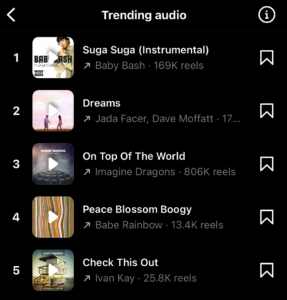
TikTok:
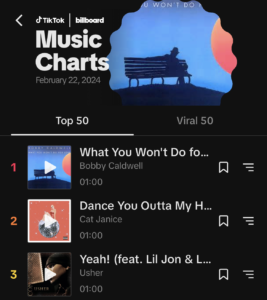
Leave a Reply